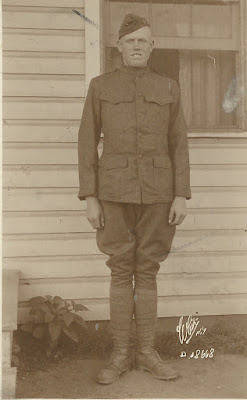 |
| Roy Tanner, picture courtesy of stephanieelesewhatcott1, FamilySearch Family Tree. |
LeRoy Parkinson Tanner served in the 141st Infantry, 36th Division, part of the American Expeditionary Forces in World War I. He had been fighting under General John J. "Black Jack" Pershing on the Mexican border (think Pancho Villa) and his regiment became part of the 36th Division in Europe. (Many thanks to a kind reader for assistance with the military terminology in this paragraph!)
We don't know much about his service; he didn't leave much of a written record. His son Wallace left a biography of his father, and I assume he also left additional information in his long autobiography he recorded in the 1970s (but I don't have that immediately at hand), so here is the information from Wallace's biography.
In 1913 he enlisted in the militia and served with the troops on the Mexican Border in 1916. He was a member of the Citizens Military Training Camp stationed on the border when World War I broke out.
When the U.S. declared war on Germany, Roy, as he was always known, was assigned to a combat division and served in France until the war’s end. He went through the entire conflict without receiving a wound, but almost died as a result of the influenza epidemic in 1918.
He was called to the front in Russia the day that the armistice was signed. After that he served for a time with the occupying forces in Russia. What he heard and saw there prompted him to observe during World War II that the United States would be better off not helping Russia so much and possibly even helping Germany against the Russians, since he felt that Russia was a much greater threat to the United States than Germany would ever be.
He returned to the U.S. in 1920 and was discharged honorably from the army. As did several of his brothers, Roy then went to work on road construction. He became a lane surveyor and construction superintendent.
(The editorializing about Russia may from Wallace Tanner due to the biography being written during the Cold War, or it may be Roy's own conclusion. Hard to tell based on how memory works and the lack of a record from Roy.)
Here is what the medical officer attached to the 141st said about the flu. It reads like he was an ignorant man and a bad diagnostician, but medical knowledge was in flux at the time, so perhaps he can be excused some of his comments, particularly since people tend to like to have pat explanations even in the face of inexplicable tragedy.
 |
| Annual Report of the Secretary of the War, 3332-3333. |
Here's a post from nine years ago with some information from his discharge papers and a short history of his regiment. (LeRoy Parkinson Tanner Military Service.) It does not seem likely that Roy was in Russia, but the history of his regiment from the Texas Military Forces Museum notes that after the Armistice, "The regiment then moved to the 16th Training Area around Tonnerre [Yonne], France, where it underwent intensive training for six months."
 |
| Yonne, France, from Pixabay. |
What were they doing for those six months? What does "intensive training" mean? Could they have been in Russia with the AEF?
This is a curious question that deserves an answer. If you have access to the Wall Street Journal, don't miss their recent article about the AEF in Russia: "The One Time American Troops Fought Russians Was at the End of World War I—and They Lost."
See also, Ben-Hur Chastaine, Story of the 36th; The Experiences of the 36th Division in the World War (Oklahoma City: Harlow Pub. Co, 1920).
So, more research is needed, and hopefully it will eventually happen.
Additional information:
Roy's American Legion Cards.
A Picture of General Pershing by Roy's Mother-in-Law.
Roy's Enlistment Document.
Roy's Biography.
After Eva died of diabetes, Roy remarried a cousin of hers, Clara Peterson (Tanner Sudweeks). Not too much is known about her early life, but since it is not noted elsewhere on the blog, she had Dissociative Identity Disorder (formerly known as Multiple Personality Disorder) and was not a suitable guardian for her stepsons. The caption on this photo gives her name from her second personality, Beth, and her family had that name engraved on her gravestone. I met her one time when I was on BYU campus in 1984 with my grandparents, and my grandfather was so kind to her and I wondered why I'd never met her before. My grandmother and I were walking behind the two of them and she told me sad stories about the abuse my grandfather and his brother suffered at her hands. If you're not familiar with DID, it's usually connected to extreme, prolonged childhood abuse, so as I said, we don't know too much about Clara/Beth's tragic life.
LeRoy Tanner and Clara's brother George Peterson were working in New Mexico in 1944 and were killed by a train at Grants, New Mexico, as they headed home one evening.
Additional information:
Roy's American Legion Cards.
A Picture of General Pershing by Roy's Mother-in-Law.
Roy's Enlistment Document.
Roy's Biography.
 |
| LeRoy P. Tanner and Eva Overson Tanner, late 1920s? |
 |
| LeRoy P. Tanner and Clara Peterson Tanner (Sudweeks) |
LeRoy Tanner and Clara's brother George Peterson were working in New Mexico in 1944 and were killed by a train at Grants, New Mexico, as they headed home one evening.
 |
| Roy's military gravestone, St. Johns, Arizona, picture by James L. Tanner. |


No comments:
Post a Comment